Picturegoer was a British phenomenon. The London based publishing company started the production of film memorabilia in 1921 and was active till 1960. It issued over 6500 different real photograph postcards on 2000 actors and actresses, but also on singers, stage stars, pop stars and film scenes. Even more popular were the publisher's film magazines, Picturegoer Magazine and the following ones such as Film Weekly, Picture Show or Film Pictorial.
![Ivor Novello]()
Ivor Novello. British postcard in the Picturegoer series, London.
![Mary Odette]()
Mary Odette. British postcard in the Picturegoer Series, no. 190. Photo: Foulsham & Banfield. Collection: Marlene Pilaete.
![Madeleine Carroll]()
Madeleine Carroll. British postcard in the Picturegoer series, London, no. 352a. Photo: Dorothy Wilding.
![John Gielgud]()
John Gielgud. British postcard in the Picturegoer Series, no. 762. Photo: Dorothy Wilding.
![John Stuart]()
John Stuart. British postcard in the Picturegoer Series, London, no. 54e.
Picturegoer Magazine was published between January 1921 and 23 April 1960. As a fan magazine, its primary focus was on film and film stars in particular.
The magazine was published monthly until November 1925, then disappeared for a number of years, but reappeared 30 May 1931 as a weekly magazine, listing films showing at British cinemas when talkies became popular.
Eventually it became a bi-weekly movie magazine featuring the screen's biggest stars that was sold at all movie theatres. Greta Garbo, Marlene Dietrich, Anna Neagle, Laurence Olivier, Petula Clark, and Richard Burton were among the hundreds of stars who graced its front cover.
![Greta Garbo]()
Greta Garbo. British postcard in the 'Picturegoer' Series, London, no. 2836.
![Hedy Lamarr]()
Hedy Lamarr. British postcard in the Picturegoer series, London, no. W 200. Photo: Metro-Goldwyn-Mayer (MGM).
![Peter Lorre]()
Peter Lorre. British postcard in the Picturegoer Series, London, no. 1033A. Photo: 20th Century Fox.
![Victor McLaglen]()
Victor McLaglen. British postcard in the Picturegoer series, London, no. 208b.
![Erich von Stroheim]()
Erich von Stroheim. British postcard in the Picturegoer series, London, no. 20a. Photo: Fox.
In the 1920s and 1940s each Picturegoer postcard measured 3-1/2" X 5-1/2", the regular postcard size. These were real photos with glossy finish on front.
On the back of each card is a number. The lettering after some of the numbers denotes the series that the card was from.
The postcards were issued in series, the first one, which ran to over 1400 cards, did not have any kind of prefix letter. The first series was followed by Series A, Series B, etc.
Groups of several poses of the same star were sometimes published in this series and were identified with an alphabetical suffix (e.g. Greta Garbo had cards published numbered 600, 600a, 600b, 600c, 600d, 600e, 600f, 600g, 600h which depicted 9 different images of the star for example).
Subsequent series were given a prefix letter with the majority of images being in sepia tone (e.g. W for those issued in the 1940s, D for the 1950s and S for the last series issued up to 1960).
![Sabu]()
Sabu. British postcard in the Picturegoer series, London, no. 1155. Photo: United Artists.
![Laurence Harvey]()
Laurence Harvey. British postcard in the Picturegoer series, London, no. D 551. Photo: J. Arthur Rank Organisation. Publicity still for Romeo and Juliet (1954).
![Anouk Aimée]()
Anouk Aimee. British postcard in the Picturegoer series, London, nr. W 826. Photo: J. Arthur Rank Organisation.
![Adrienne Corri]()
Adrienne Corri. British postcard in the Picturegoer Series, London, no. D 584. Photo: J. Arthur Rank Oragnisation.
![Eva Bartok]()
Eva Bartok. British postcard in the Picturegoer Series, London, no. D 235. Photo: J. Arthur Rank Organisation.
Picturegoer was the only publishing company which attached a special importance to the art of colorizing. There are even small series dedicated to that art, Colourgraph, Cameo, Filmpartners.
The K series was devoted to cameo portraits and the P series to film partners. The K and P series were issued in b/w and coloured versions. The coloured versions were given the prefixes KC and PC but the poses were identical to the b/w versions. T
The C series, known as the Colourgraph Series, was devoted entirely to handcoloured images. The FS Series was related exclusively to film scenes. Special sets of different cards were issued for specific films in the D & W Series.
The individual card numbers are only listed on the reverse side of each card. Also the company name can be seen there. The production took place in a gentle sepia brown and in light version. The cards have the regular postcard size.
![Maurice Chevalier]()
Maurice Chevalier. British postcard in the Colourgraph series, London, no. C 64.
![Mabel Poulton]()
Mabel Poulton. British postcard in the Colourgraph Series, London, no. C 82.
![Greta Garbo]()
Greta Garbo. British postcard in the Colourgraph Series, London, no. C 81.
![Herbert Marshall]()
Herbert Marshall. British postcard in the Colourgraph Series, London, no. C 233. Photo: M.G.M.
![Winifred Shotter]()
Winifred Shotter. British postcard in the Colourgraph Series, London, no. C 146.
Also the postcard series with names such as Colourgraph, Famous Filmpartner Cards, Film Shots (= Film Weekly) and Filmkurier Series were all produced by the Picturegoer company.
Not only postcards and magazines established a good reputation for Picturegoer. They also produced nice supplements within the magazines (film programs), annual film books or other nice memorabilia.
After World War II, Picturegoer magazine found itself competing with periodicals published by the Rank Organisation, Odeon Cinemas, and Associated British Cinemas, which replaced Picturegoer with their own magazines at their theatre kiosks. As a result, Picturegoer became more sensational in the 1950s, with covers featuring cheesecake and beefcake-style artwork.
Picturegoer eventually merged with the pop music magazine Disc Date. Shortly after the Picturegoer name was dropped and the publication concentrated solely on music. The last issue of Picturegoer was published on 23 April 23, 1960 with a cover showcasing Jackie Rae and Janette Scott.
![Brian Aherne and Victoria Hopper in The Constant Nymph (1933)]()
Brian Aherne and Victoria Hopper in The Constant Nymph (1933). British Real Photograph postcard in the Film Partners series, no. P 121. Photo: Gaumont-British. Publicity still for The Constant Nymph (Basil Dean, 1933).
![Ivor Novello, Elizabeth Allan]()
Ivor Novello and Elizabeth Allan. British postcard in the Film Partners series, no. P 41. Photo: Stanborough.
![Tullio Carminati and Grace Moore in One Night of Love]()
Tullio Carminati and Grace Moore in One Night of Love. British postcard in the Film Partners Series, London, no. P 151. Photo: Columbia. Publicity still for One Night of Love (Victor Schertzinger, 1934).
![Jack Hulbert and Patricia Ellis in Paradise for Two]()
Jack Hulbert and Patricia Ellis in Paradise for Two. British postcard in the Film Partners Series, London, no. P 241. Photo: London Films. Publicity still for Paradise for Two/Gaiety Girls (Thornton Freeland, 1937).
![Ralph Lynn, Winifred Shotter]()
Ralph Lynn and Winifred Shotter. British postcard in the Film Partners Series by Real Photograph, London, no. 81. Photo: British & Dominions.
This was the third post in a new series on film star postcard publishers. For earlier posts, see the links at right under the caption 'The Publishers'. Next Wednesday: France's CE or Cinemagazine Edition.
Sources: Garbo Forever, Immortal Ephemera, Wikipedia and IMDb.

Ivor Novello. British postcard in the Picturegoer series, London.

Mary Odette. British postcard in the Picturegoer Series, no. 190. Photo: Foulsham & Banfield. Collection: Marlene Pilaete.

Madeleine Carroll. British postcard in the Picturegoer series, London, no. 352a. Photo: Dorothy Wilding.

John Gielgud. British postcard in the Picturegoer Series, no. 762. Photo: Dorothy Wilding.

John Stuart. British postcard in the Picturegoer Series, London, no. 54e.
Fan Magazine
Picturegoer Magazine was published between January 1921 and 23 April 1960. As a fan magazine, its primary focus was on film and film stars in particular.
The magazine was published monthly until November 1925, then disappeared for a number of years, but reappeared 30 May 1931 as a weekly magazine, listing films showing at British cinemas when talkies became popular.
Eventually it became a bi-weekly movie magazine featuring the screen's biggest stars that was sold at all movie theatres. Greta Garbo, Marlene Dietrich, Anna Neagle, Laurence Olivier, Petula Clark, and Richard Burton were among the hundreds of stars who graced its front cover.

Greta Garbo. British postcard in the 'Picturegoer' Series, London, no. 2836.

Hedy Lamarr. British postcard in the Picturegoer series, London, no. W 200. Photo: Metro-Goldwyn-Mayer (MGM).

Peter Lorre. British postcard in the Picturegoer Series, London, no. 1033A. Photo: 20th Century Fox.
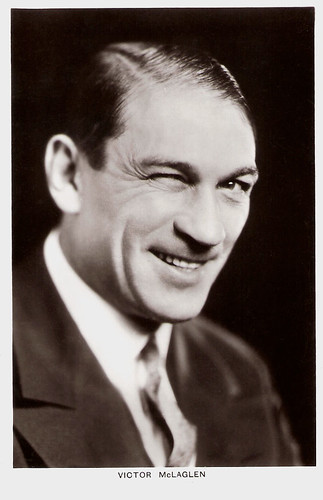
Victor McLaglen. British postcard in the Picturegoer series, London, no. 208b.

Erich von Stroheim. British postcard in the Picturegoer series, London, no. 20a. Photo: Fox.
Numbers
In the 1920s and 1940s each Picturegoer postcard measured 3-1/2" X 5-1/2", the regular postcard size. These were real photos with glossy finish on front.
On the back of each card is a number. The lettering after some of the numbers denotes the series that the card was from.
The postcards were issued in series, the first one, which ran to over 1400 cards, did not have any kind of prefix letter. The first series was followed by Series A, Series B, etc.
Groups of several poses of the same star were sometimes published in this series and were identified with an alphabetical suffix (e.g. Greta Garbo had cards published numbered 600, 600a, 600b, 600c, 600d, 600e, 600f, 600g, 600h which depicted 9 different images of the star for example).
Subsequent series were given a prefix letter with the majority of images being in sepia tone (e.g. W for those issued in the 1940s, D for the 1950s and S for the last series issued up to 1960).

Sabu. British postcard in the Picturegoer series, London, no. 1155. Photo: United Artists.

Laurence Harvey. British postcard in the Picturegoer series, London, no. D 551. Photo: J. Arthur Rank Organisation. Publicity still for Romeo and Juliet (1954).

Anouk Aimee. British postcard in the Picturegoer series, London, nr. W 826. Photo: J. Arthur Rank Organisation.
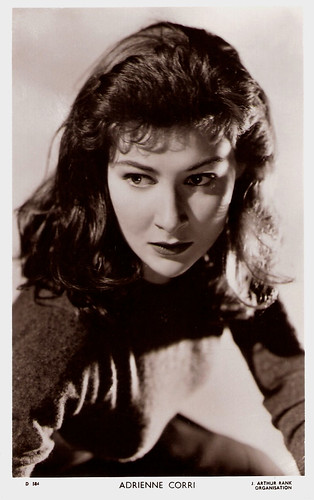
Adrienne Corri. British postcard in the Picturegoer Series, London, no. D 584. Photo: J. Arthur Rank Oragnisation.
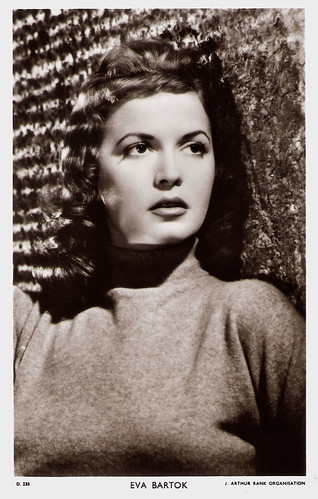
Eva Bartok. British postcard in the Picturegoer Series, London, no. D 235. Photo: J. Arthur Rank Organisation.
The art of colorizing
Picturegoer was the only publishing company which attached a special importance to the art of colorizing. There are even small series dedicated to that art, Colourgraph, Cameo, Filmpartners.
The K series was devoted to cameo portraits and the P series to film partners. The K and P series were issued in b/w and coloured versions. The coloured versions were given the prefixes KC and PC but the poses were identical to the b/w versions. T
The C series, known as the Colourgraph Series, was devoted entirely to handcoloured images. The FS Series was related exclusively to film scenes. Special sets of different cards were issued for specific films in the D & W Series.
The individual card numbers are only listed on the reverse side of each card. Also the company name can be seen there. The production took place in a gentle sepia brown and in light version. The cards have the regular postcard size.

Maurice Chevalier. British postcard in the Colourgraph series, London, no. C 64.

Mabel Poulton. British postcard in the Colourgraph Series, London, no. C 82.
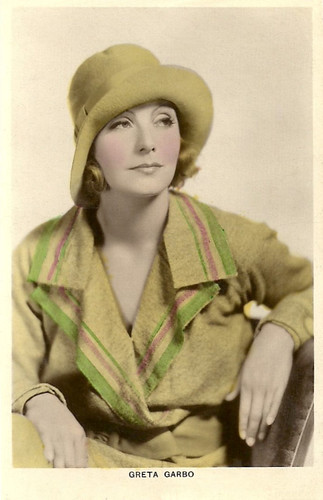
Greta Garbo. British postcard in the Colourgraph Series, London, no. C 81.

Herbert Marshall. British postcard in the Colourgraph Series, London, no. C 233. Photo: M.G.M.
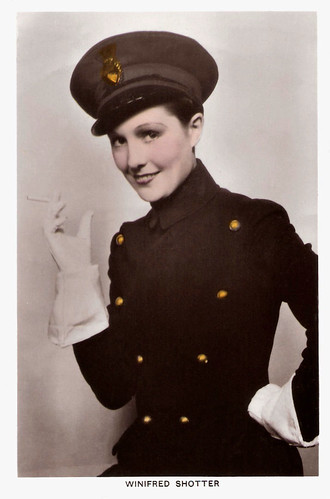
Winifred Shotter. British postcard in the Colourgraph Series, London, no. C 146.
Good Reputation
Also the postcard series with names such as Colourgraph, Famous Filmpartner Cards, Film Shots (= Film Weekly) and Filmkurier Series were all produced by the Picturegoer company.
Not only postcards and magazines established a good reputation for Picturegoer. They also produced nice supplements within the magazines (film programs), annual film books or other nice memorabilia.
After World War II, Picturegoer magazine found itself competing with periodicals published by the Rank Organisation, Odeon Cinemas, and Associated British Cinemas, which replaced Picturegoer with their own magazines at their theatre kiosks. As a result, Picturegoer became more sensational in the 1950s, with covers featuring cheesecake and beefcake-style artwork.
Picturegoer eventually merged with the pop music magazine Disc Date. Shortly after the Picturegoer name was dropped and the publication concentrated solely on music. The last issue of Picturegoer was published on 23 April 23, 1960 with a cover showcasing Jackie Rae and Janette Scott.
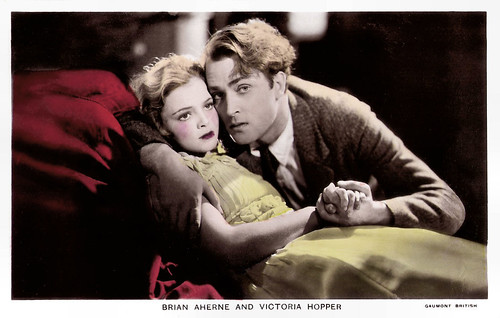
Brian Aherne and Victoria Hopper in The Constant Nymph (1933). British Real Photograph postcard in the Film Partners series, no. P 121. Photo: Gaumont-British. Publicity still for The Constant Nymph (Basil Dean, 1933).

Ivor Novello and Elizabeth Allan. British postcard in the Film Partners series, no. P 41. Photo: Stanborough.
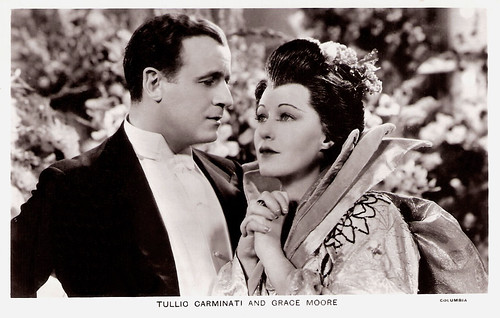
Tullio Carminati and Grace Moore in One Night of Love. British postcard in the Film Partners Series, London, no. P 151. Photo: Columbia. Publicity still for One Night of Love (Victor Schertzinger, 1934).

Jack Hulbert and Patricia Ellis in Paradise for Two. British postcard in the Film Partners Series, London, no. P 241. Photo: London Films. Publicity still for Paradise for Two/Gaiety Girls (Thornton Freeland, 1937).

Ralph Lynn and Winifred Shotter. British postcard in the Film Partners Series by Real Photograph, London, no. 81. Photo: British & Dominions.
This was the third post in a new series on film star postcard publishers. For earlier posts, see the links at right under the caption 'The Publishers'. Next Wednesday: France's CE or Cinemagazine Edition.
Sources: Garbo Forever, Immortal Ephemera, Wikipedia and IMDb.